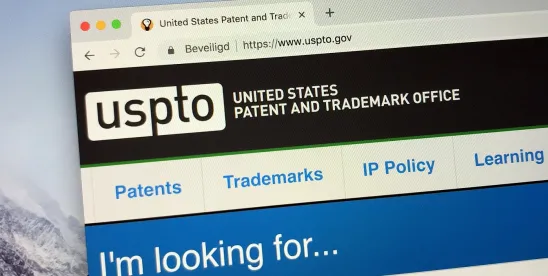In a May 10, 2024, Notice of Proposed Rulemaking (NPRM), the USPTO proposed sweeping changes in the rules governing the filing of terminal disclaimers. If the USPTO implements the proposed changes, entire patent families could be wiped out if just one claim of one patent in the family is found invalid over prior art. Patent owners could have a lot more to worry about than just preserving common ownership of terminally disclaimed patents. The public hue and cry thus far have been significant. Here, we discuss why.
How Things Are Now
When an applicant files a terminal disclaimer, the applicant agrees to disclaim any term extending beyond the term of a commonly owned patent or patent application with claims that are deemed close in scope to the claims of the disclaimed patent or application. The applicant also agrees that the disclaimed patent is enforceable only so long as it remains commonly owned with the patent properties that are the subject of the terminal disclaimer.
Applicants have filed terminal disclaimers fairly readily, in large part because the Federal Circuit has held that such filings are in no way an admission of patentable indistinctness or obviousness. As a result, invalidating a claim in one of two patents tied together by a terminal disclaimer does not necessarily establish invalidity of claims in the other patent. Under the proposed rule, terminal disclaimers effectively would be an admission of obviousness of patents tied together by terminal disclaimers.
How Things Might Be
The proposed rules effectively overrule existing case law. If implemented, the rules will require an applicant to agree that the patent with the terminal disclaimer will not be enforced if any claim of the patent to which it is disclaiming is invalidated by prior art.
The ramifications are huge. Frequently, patent applicants file a number of patent applications with similar claims, to build a patent family, or what may be termed a “patent thicket.” A patent owner may choose to assert some but not all patents in the thicket against an accused infringer. The accused infringer will know that a successful challenge to the asserted patents does not end the issue, because there are other patents waiting in the background. With the proposed rules, if members of the thicket are subject to terminal disclaimers, the entire thicket could be uprooted if only one claim of one patent is invalidated.
The purported policy reason behind the proposed changes is to promote competition by lowering the cost of challenging groups of patents tied by terminal disclaimers, resulting in reducing barriers to market entry and lower costs for consumers. Coupled with the recently proposed increases in terminal disclaimer fees, however, there is a distinct possibility that the overall effect will be for applicants to challenge terminal disclaimer requirements, potentially lengthening patent application pendency and increasing patent examiner workloads.
Under the proposed rules, in a litigation in which a patent owner is enforcing several patents that are tied together by one or more terminal disclaimers, an accused infringer could invalidate all of those patents by invalidating a single claim of one of the patents. This consequence could have a huge impact on the filing of post-grant petitions in the USPTO (either inter partes review (IPR) or post-grant review (PGR)) and patent litigation. First, because the accused infringer could invalidate all the patents with an IPR or PGR petition on one patent, rather than having to file one for each patent, and as the cost and burden to prepare one petition can be considerably less than for multiple petitions, post-grant challenges may become the de facto response to patent infringement allegations. Second, because one successful post-grant proceeding would invalidate the claims of all the asserted patents, and as one petition can be prepared and filed more quickly than several, courts are more likely to stay the whole litigation based on the grant of a single IPR petition on a single patent. Consequently, the ability to file a single IPR or PGR petition to attack an entire patent family can increase an accused infringer’s chances of obtaining a stay of litigation and invalidating all the patents tied together by terminal disclaimers.
To the extent that patent owners have complained about having to fight off challenges to multiple patents, having a single such challenge would simplify matters and reduce costs for patent owners. The “up or down” consequence for an entire patent family from invalidating a single patent claim is likely to be a lot less desirable for patent owners than the reduced costs of defending against a single invalidity challenge.
The USPTO states that the proposed rules do not require a disclaimant to make a statement in the terminal disclaimer that the conflicting claims are not patentably distinct. While technically this may be the case, practically speaking it is not. Under the proposed rule, filing a terminal disclaimer is essentially an admission of obviousness.
In the NPRM, the USPTO lists a number of scenarios in which terminal disclaimers may be filed in patent families of two or more patents and patent applications, and the consequences of those terminal disclaimer filings. Analyzing all of these is beyond the scope of this blog. We can say, however, that one potential consequence of the proposed rules is that patent applicants may be more motivated to challenge terminal disclaimer requirements.
If an applicant wishes to avoid filing a terminal disclaimer, the applicant has the following options:
- Combine conflicting claims into a single application; alternatively. separate patentably distinct claims into another application and file a terminal disclaimer in the application with the indistinct claims;
- Cancel or amend any conflicting claims in the application or in the other application containing the conflicting claims that form the basis of the nonstatutory double patenting rejection;
- Argue that the rejected claims in the application are patentably distinct from the claims of the reference patent or application; or
- File a reissue application of the patent whose claims formed the basis of the nonstatutory double patenting in order to add cancelled conflicting claims from the application into the reissue application.
Takeaways
Under the proposed rules, applicants may need to reevaluate their filing practices, including their practice in filing continuation applications, to avoid, as much as possible, filing terminal disclaimers and tying patent families together.
Traversing terminal disclaimer requirements during prosecution also may become part of a patent applicant’s toolbox. While such traversals can increase patent prosecution costs, there could be a tradeoff between those costs and proposed substantial increase in terminal disclaimer fees, as discussed in our prior blog here.
Applicants may need to take steps to ensure that the claims of subsequent continuing applications have sufficiently distinct claim sets from those in parent applications so they do not trigger nonstatutory double patenting rejections. For example, instead of filing only minor variations to the claims of the parent application, the applicant may consider filing one application with a larger claim set to cover more variations in one application to avoid an obviousness-type double patenting rejection. Even if including more variations in a single application will induce a restriction requirement, the divisional applications will avoid nonstatutory double patenting rejections under the safe harbor provision of 35 U.S.C. § 121.
These consequences for invalidity findings and contradictions in appellate court rulings call into question whether the USPTO has authority for these proposed rules.




 />i
/>i

